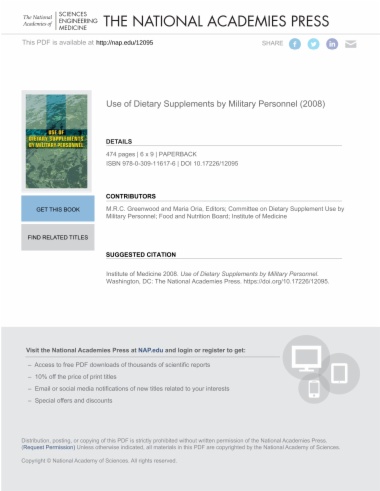Dietary supplements are widely available through a rapidly expanding market of products commonly advertised as beneficial for health, performance enhancement, and disease prevention. Given the importance and frequent evaluation of physical performance and health as a criteria to join and remain in the military, the use of these products by military personnel has raised concern regarding over-all and long-term efficacy and safety. This evaluation is especially difficult, as many of these supplements contain multiple ingredients, have a changing composition over time, or are used intermittently at doses difficult to measure.
This book analyzes the patterns of dietary supplement use among military personnel, examines published reviews of the scientific evidence, and identifies those dietary supplements that are beneficial and/or warrant concern due to risks to health or performance. The book also recommends a system to monitor adverse health effects and a framework to identify the need for active management of dietary supplements by military personnel.
Military policy makers, personnel, and recruits will find this book useful, as will nutritionists, athletes, and others working in strenuous environments.
- Cover
- Front Matter
- Summary
- 1 Introduction
- 2 Recent Survey Findings and Implications for Future Surveys of Dietary Supplement Use
- 3 Vitamins and Essential Minerals for Military Personnel
- 4 Other Dietary Supplements for Military Personnel
- 5 Framework to Review the Safety of Dietary Supplements for Use by Military Personnel
- 6 Monitoring Adverse Health Effects Associated with Dietary Supplement Use by Military Personnel
- 7 Research Needs
- Appendix A: Workshop Agenda
- Appendix B: Workshop Papers
- Appendix C: Findings from Recent Surveys on Dietary Supplement Use by Military Personnel and the General Population
- Appendix D: Case Studies
- Appendix E: Adverse Event Reporting Forms
- Appendix F: Biographical Sketches of Workshop Speakers
- Appendix G: Biographical Sketches of Committee Members
- Appendix H: Acronyms and Abbreviations
- Appendix I: Glossary

